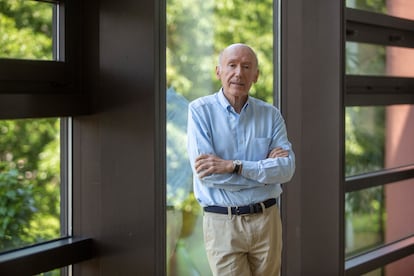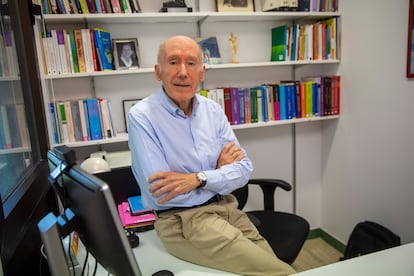Psychologist Enrique Echeburúa: ‘People who die by suicide want to stop suffering, not to stop living’
The psychologist just published his book ‘Death by Suicide’ in which he explains it as a public health problem, paying particular attention to the suffering of survivors

Enrique Echeburúa (San Sebastian, Spain, 72 years old), Professor Emeritus of Clinical Psychology at the University of the Basque Country (UPV/EHU), says that when a suicide occurs, there are other victims beyond the deceased, and they do not receive adequate support. “The first thing [we need to do] is make it easier for the family that has lost a child, or the person who has lost their partner, to unburden them, to be able to talk about it,” he explains. “Silence is the worst thing, because many people don’t talk to them, even their social circle of neighbors and friends, because they don’t know how to approach [them], which leads to social isolation,” Echeburúa continues in a video call conversation.
The psychologist just published a book entitled Death by Suicide. In just over 150 pages, Echeburúa summarizes the fundamental aspects of a particularly human and painful phenomenon. “We have a very high cognitive capacity that can make us experience suffering and disappointments very intensely, and it makes us aware that we can put an end to our lives. People who attempt suicide want to stop suffering, not stop living,” he says. In the book, he presents suicide as a public health problem and explains it so we can better understand it and combat the stigma that has made it difficult to take adequate prevention measures and increased the suffering of survivors.
Question: Can suicide be addressed as if it were a disease?
Answer. Suicide is not a mental disorder like depression or addiction. In a high percentage—70% to 90%—of cases, there is an underlying mental disorder but there are 10% to 20%, who are people who may reach a point where they make an existential calculation, see that their life no longer makes sense, that they do not have a life project, and they feel isolated and experience a certain tiredness of living. These people may be influenced by external factors, such as a financial setback. At a given moment, shame or feeling socially ostracized can also lead them to an impulsive act of desperation, because death is seen as the only way to escape suffering.
Q. At the moment, there’s a lot of concern about suicides among young people and adolescents in particular. Has the situation worsened?
A. In Spain, most deaths by suicide do not occur in young people. The highest incidence is in adulthood, between 30 and 59 years of age, and a second peak occurs in those over 65 years of age, who may account for approximately 25 to 30% [of the cases]. Teenagers and young adults, between 15 and 30 years of age, may account for about 13%. [Suicide] is much less common than in the elderly, but we are much more sensitive to suicide by a young person. Another important issue is that, in Spain, the number of deaths caused by traffic accidents has decreased dramatically in recent years, and those deaths affected mostly young people. Now, suicide seems much more relevant as [a cause of] unnatural death in this [age] group.
Q. There is also more concern about mental disorders other than suicide among teenagers.
A. There are other phenomena [that are] linked to suicide but are not suicide, such as self-harm in adolescent girls and suicidal ideation. There are many people who have suicidal ideation that, if not treated properly, can eventually translate into a fatal suicide attempt. In Spain, since the pandemic, there has been a clear increase in the number of people with suicidal ideation and teenagers who self-harm. On the other hand, with respect to the number of deaths by suicide, there hasn’t been enough time for us to be able to draw conclusions. In principle, suicide is relatively stable numerically. The most relevant fact is not the increase, but the fact that the numbers have not decreased, when [deaths] have been reduced in other areas, such as traffic accidents, homicides and femicides. It is also true that there is a much greater sensitivity to this phenomenon now, which is clearly a positive thing, because it can lead us to invest more resources [in stopping it].
Q. Why hasn’t the number of deaths by suicide decreased?
A. There is a lack of understanding, and suicide prevention programs, which are [just] starting to develop now, have not been done in a meaningful way. The situation is much better than it was five years ago. Suicide prevention programs are included in [Spain’s] National Mental Health Strategy, which has made this problem a priority issue. [Spain’s] autonomous communities also have suicide prevention plans at the school level. We are training the police, firefighters and professionals in [matters related to] this type of behavior. These [initiatives] will likely yield results in the medium term.

Q. Is there anything that could be done to prevent suicide that is not being done yet?
A. If we’re talking about adolescents, for example, much more needs to be done. Many teenagers are very sensitive to emotional upheaval, which is experienced far more intensely in adolescence than in adult life; serious disappointments—in romantic relationships, with parents, with friends, school performance, being bullied for being different—can lead them to attempt suicide in a fit of impulsivity. The family and the role of the school play a very important role for teenagers. In the family, parents may not detect the risk of suicide, but they may see that their child has depression, or an anxiety problem, or stops eating or becomes addicted to social media. These are risk factors, and it is a good idea to get those problems checked out, not necessarily [because of] suicide. In the most serious cases, you can also involve the school, or educational psychologists who may work at the school, or a primary care physician to refer [the teenager] to a mental health center. And there are also hotlines that have been set up by the government, the ANAR Foundation, the Hope Hotline, the hotline set up by the Ministry of Health. All of this makes it easier to deal with crisis situations and makes it less likely for a fatal suicide attempt to occur. Then, we must also realize that sometimes suicide occurs impulsively and there is no [unusual] behavior to detect. But… controlling access to drugs, places like high bridges and access to firearms [can help prevent it].
Q. And are there general suicide prevention measures for people of all ages?
A. Additional risk factors should be monitored, such as having a family member who died by suicide, having attempted suicide [before], being male, being over 60 years old, living alone or having a chronic or debilitating disease. We should pay attention to these risk factors in order to provide extra medical, psychological and social support. As we have said, it is also important to monitor serious mental disorders, depression, psychosis…alcoholism or an eating disorder.
From the educational point of view, both in a family and at school, it is important to create what we call protective factors—[ways] to make these people resilient in the face of disappointments, trials and tribulations or setbacks that they may experience in their lives. [Such strategies are] based on building self-esteem. For example: do not ridicule them if they are not at the head of the class. In general, it is a matter of ensuring that they have emotional stability, that they are taught to solve problems and to manage emotions and stressful situations, to foster social relationships, to share their sorrows and joys with the people around them. All of that is very important protection for a person.
Q. Can we improve our knowledge about suicide to better address it?
A. There is something that is not usually done…called a “psychological autopsy.” Essentially, it was created at the request of insurance companies to determine whether a person’s cause of death was an accident or a suicide, because sometimes insurance policies do not cover suicides. Therefore, they were interested in determining the cause of death. Then, they wanted to see which circumstances in each specific case could have led to that person’s loss of life. And this was a study that was carried out with the [help of the deceased person’s] relatives, with the people who had been around that person; [the study took place] a few months after the death, when people were ready to provide information. Thus, we wanted to know more about the variables that lead to suicide to establish better prevention programs. This [study] is not done systematically, because it is very complicated to do so, but it would shed light on how to conduct better prevention campaigns and more specific treatments for different age groups.
Sign up for our weekly newsletter to get more English-language news coverage from EL PAÍS USA Edition
Tu suscripción se está usando en otro dispositivo
¿Quieres añadir otro usuario a tu suscripción?
Si continúas leyendo en este dispositivo, no se podrá leer en el otro.
FlechaTu suscripción se está usando en otro dispositivo y solo puedes acceder a EL PAÍS desde un dispositivo a la vez.
Si quieres compartir tu cuenta, cambia tu suscripción a la modalidad Premium, así podrás añadir otro usuario. Cada uno accederá con su propia cuenta de email, lo que os permitirá personalizar vuestra experiencia en EL PAÍS.
¿Tienes una suscripción de empresa? Accede aquí para contratar más cuentas.
En el caso de no saber quién está usando tu cuenta, te recomendamos cambiar tu contraseña aquí.
Si decides continuar compartiendo tu cuenta, este mensaje se mostrará en tu dispositivo y en el de la otra persona que está usando tu cuenta de forma indefinida, afectando a tu experiencia de lectura. Puedes consultar aquí los términos y condiciones de la suscripción digital.
More information
Últimas noticias
There is as much life left to discover on planet Earth as that which is already known
Dozens presumed dead, around 100 injured in fire at Swiss Alps bar during New Year’s celebration
Is porn for women different from conventional porn? We spoke to those who make it
Cartagena de Indias is sinking: What can the city do to mitigate it?
Most viewed
- Sinaloa Cartel war is taking its toll on Los Chapitos
- Reinhard Genzel, Nobel laureate in physics: ‘One-minute videos will never give you the truth’
- Oona Chaplin: ‘I told James Cameron that I was living in a treehouse and starting a permaculture project with a friend’
- David King, chemist: ‘There are scientists studying how to cool the planet; nobody should stop these experiments from happening’
- Why the price of coffee has skyrocketed: from Brazilian plantations to specialty coffee houses











































